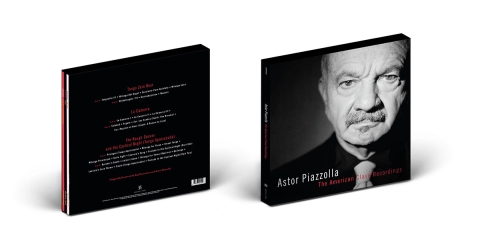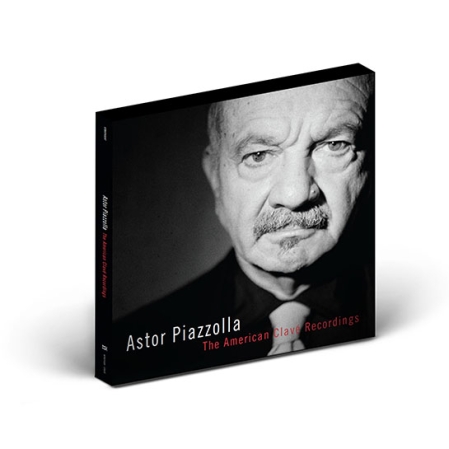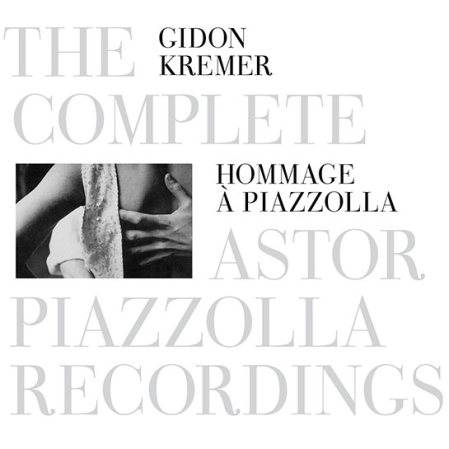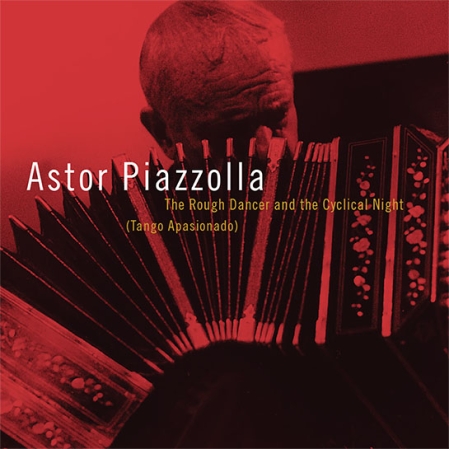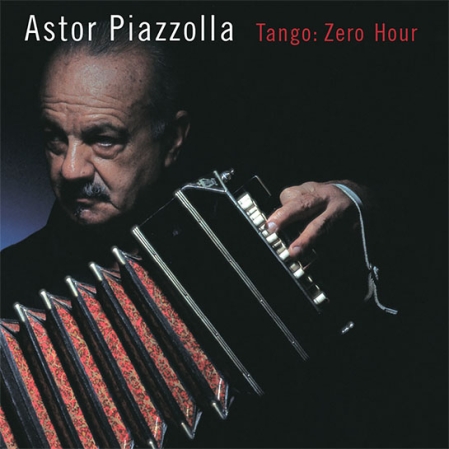Nuevo tango master Piazzolla composed these pieces for director-choreographer Graciela Daniele’s 1987 adaptation of Jorge Luis Borges stories Tango Apasionado, which the New York Times praised as “a music-theater-dance piece of breathtaking intensity.” Musicians include sax/clarinet player Paquito D’Rivera.
Originally released in 1989, Astor Piazzolla’s The Rough Dancer and the Cyclical Night was recorded in New York in September 1987, with an ensemble that included Fernando Suárez Paz (violin), Pablo Zinger (piano), Paquito D’Rivera (alto sax, clarinet), Andy González (bass), and Rodolfo Alchourrón (electric guitar). The recording was produced by Kip Hanrahan and originally released by American Clavé. It is the third Nonesuch reissue of Piazzolla’s classic American Clavé recordings, which also include Tango: Zero Hour and La Camorra. The music of The Rough Dancer and the Cyclical Night was commissioned by Intar Hispanic American Arts Center for their production of Tango Apasionado, which included lyrics by William Finn. That work was adapted by Graciela Daniele and Jim Lewis, and was conceived, choreographed and directed by Graciela Daniele.
Astor Piazzolla’s nuevo tango, which incorporates classical forms and jazz elements into the traditional tango, was so controversial at its advent that Piazzolla had his life threatened on numerous occasions and was even exiled from Argentina. The traditional tango, born out of the bordellos of Buenos Aires in the way that jazz began in New Orleans, had been haunted by its origins for decades. Piazzolla, with his innovative style and desire to legitimize the tango and bring it to a serious musical audience, changed the face of the music forever.
Born in Mar Del Plata, Argentina in 1921, Piazzolla moved to New York with his father at an early age and lived there until 1937. At age nine he was asked by the famed tango singer/composer Carlos Gardel to appear in his movie El Dia Que Me Quieras. Upon his return to Buenos Aires, he learned to play the bandoneón, began arranging for Anibal Troilo’s orchestra (one of the main tango bands of the day), and studied with the composer Alberto Ginastera.
The year 1954 marked a pivotal point in Piazzolla’s career, when he won a scholarship to study composition with the celebrated pedagogue Nadia Boulanger in Paris. It was Boulanger who encouraged Piazzolla to develop the popular music of his heritage, to make tango a serious music. In 1955 he organized his Octeto Buenos Aires, after his studies with Boulanger and an encounter with Gerry Mulligan’s Octet. It signified the beginning of what came to be known as nuevo tango.
Other ensembles followed, including Piazzolla’s first quintet, which worked together from 1960 to 1970. The New Tango Quintet, convened in 1978, was in a class by itself. When Tango: Zero Hour was released, the ensemble had spent nearly 10 years together and Piazzolla was at the peak of his powers. SPIN magazine called Tango: Zero Hour “extraordinary,” and The Village Voice called Piazzolla “a modern master.” Jon Pareles of the New York Times said, “To hear Mr. Piazzolla’s tangos as musical marvels is beside the point. As edgy lines and long-breathed tunes defy and embrace one another, the tangos suggest that even in the modern world, romance survives.”
The release of The Rough Dancer and the Cyclical Night in 2000 marked the fifth Nonesuch release to feature Astor Piazzolla. It was preceded by the 1999 release of the La Camorra (1987), preceded by 1998 release of the 1986 classic recording Tango: Zero Hour, with new liner notes and packaging. In 1988, a recording of Piazzolla’s Concierto para bandoneón and Tres tangos was released, and in 1990 he made his last recording, Five Tango Sensations, which was commissioned by the Kronos Quartet. (Piazzolla’s first composition for Kronos, Four, for Tango, appears on their 1988 release Winter Was Hard.) The music of Piazzolla is also featured on three Nonesuch recordings by the violinist Gidon Kremer: Eight Seasons, Hommage à Piazzolla, and El Tango.
PRODUCTION CREDITS
Produced by Kip Hanrahan and Astor Piazzolla
Recorded August and September 1987 in New York at Radio City Studio, A&R Studio, and Sorcerer Studio
Recording Engineers: Don Hunerberg, David Baker, and Roger Moutenot
Mixed at Skyline Studio
Mixing Engineers: Roger Moutenot and John Fausty
Assistant Mixing Engineer: Tom Durack
Mastered at Sterling Sound, New York City
Engineer: Greg Calbi
Production Assistant: Mic Holwin
Associate Producer: Pablo Zinger
All music written by Astor Piazzolla
Design by John Gall
Executive Producer: Scott Marcus
79515
MUSICIANS
Astor Piazzolla, bandoneón
Fernando Suárez Paz, violin
Pablo Ziegler, piano
Paquito D’Rivera, alto sax, clarinet
Andy Gonzalez, bass
Rodolfo Alchourron, electric guitar




